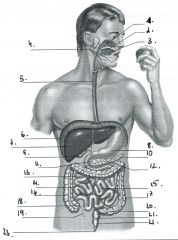![]()
![]()
![]()
Use LEFT and RIGHT arrow keys to navigate between flashcards;
Use UP and DOWN arrow keys to flip the card;
H to show hint;
A reads text to speech;
57 Cards in this Set
- Front
- Back

Label |
|
|
|
uvula |
|
|
|
pharynx |
|
|
|
salivary glands |
produce saliva to chemically digest feed |
|
|
soft palate |
functions in closing off the openings to the ears and nose |
|
|
Why don't you swallow food into your lungs |
it is prevented from entering the trachea the epiglottis |
|
|
epi- |
above |
|
|
-glottis |
refers to the opening to the esophagus |
|
|
esophagus |
|
|
|
peristalsis |
rhythmic contraction of muscles |
|
|
esophagus ends ... |
where it joins the stomach |
|
|
Cardiac sphicter |
|
|
|
gastric juice |
|
|
|
stomach |
|
|
|
Chyme |
term used for food after the stomach digestes it |
|
|
Hydrochloric |
important gastric secretion |
|
|
pepsin |
|
|
|
what is partially absorbed from the stomach into the bloodstream |
water, alcohol, some medications |
|
|
how is the stomach protected |
inner lining of the stomach is protected by a layer of mucous produced by the stomach itself |
|
|
chyme moves from the stomach into |
first section of the small intestine |
|
|
pyloric sphincter |
between stomach and the small intestine |
|
|
How long does food typically spend in the stomach |
2 to 4 hours |
|
|
small intestine |
|
|
|
small intestine can be divided into three sections |
|
|
|
digestion in small intestine |
|
|
|
where does the enzymes that act chemically on food in the small intestine comes from ... |
|
|
|
pencreatic duct |
|
|
|
how long does the digestion of food in the small intestine takes |
3 to 10 hours |
|
|
emulsified |
|
|
|
Bile |
|
|
|
bile duct |
carries bile into small intestine |
|
|
how does aborption in the small intestine occur |
by many tiny finger-like projections that line the walls |
|
|
villi |
tiny finger-like projection that line the walls of the small intestine |
|
|
the inner surface of the small intestine is full of ... |
|
|
|
what molecules are absorbed i from the capillaries in the small intestine |
|
|
|
where does the food goes after its digested in the small intestine |
large intestine or colon |
|
|
large intestine |
|
|
|
what are the 3 portions of the large intestine |
|
|
|
duties of large intestine |
|
|
|
appendix |
|
|
|
rectum |
|
|
|
anus |
opening of the rectum to the outside of the body |
|
|
define peristalsis and how it functions |
involuntary constriction and relaxation of the muscles of the intestine or another canal, creating wavelike movements that push the contents of the canal forward. |
|
|
what are two types of digestion? |
chemical and mechanical. |
|
|
Where does mechanical digestion occurs |
mouth - chewed stomach - churned and mix small intestine - large lipid molecules are broken down by bile |
|
|
Where does chemical digestion occurs |
mouth - saliva acts on food as chewed stomach - gastric juices act on food small intestine - intestinal and pancreatic juices complete chemical digestion |
|
|
Where are food materials absorbed into the circulatory system? |
in the small intestine
|
|
|
how is the pancreas involved in the digestion of food in the alimentary canal? |
produces and sends digestive enzymes through the pancreatic duct to the small intestine where they chemically digest food. |
|
|
3 important functions of the large intestine |
|
|
|
digestive enzymes in the mouth (Type of Enzyme - digestive secretion - Action) |
Amylase - Saliva - begins digestion of starch to maltose |
|
|
digestive enzymes in the stomach (Type of Enzyme - digestive secretion - Action)
|
Protease - Gastric Juice - Begins digestion of proteins |
|
|
digestive enzymes in the small intestine (Type of Enzyme - digestive secretion - Action) |
Pancreatic Juice Amylase - Completes digestion of starch to maltose Protease - Continues digestion of proteins Lipase - Completes digestion of lipids to fatty acids and glycerol
Intestinal Juice Protease - Completes digestion of proteins to amino acids Carbohydrase - Completes digestion of carbohydrates to simple sugars |
|
|
What is an enzyme |
biological catalyst (speed up chemical reactions without themselves being altered in the process. |
|
|
5 factors that affect enzyme action |
|
|
|
function of the liver |
homeostatic function: filters harmful substances out of the blood and converts them to less toxic molecules. (i.e. alcohol) |
|
|
what are the cells in the liver called and what they are sensitive to |
chemoreceptors - monitor the level of a chemical sensitive to glucose level |
|
|
function of the pancreas |
producing insulin if blood glucose level in blood rises producing glucagon if glucose level in blood drop. |

